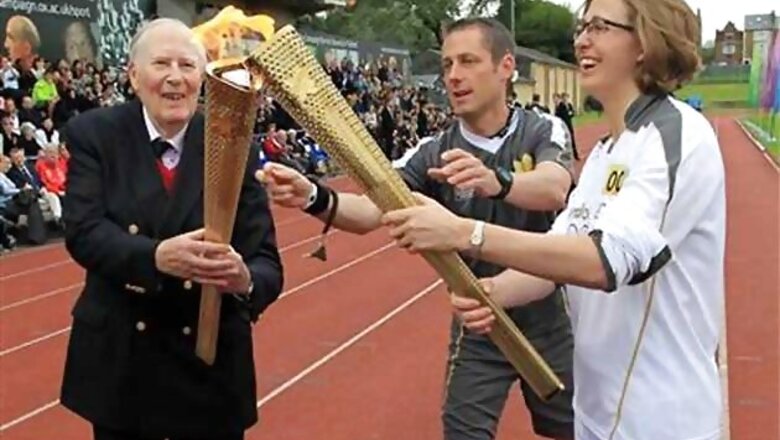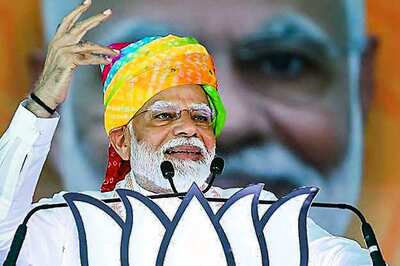
views
London: If you look closely at pictures from the 1948 Olympics opening ceremony, the last Games to be held in Britain, you might notice the British flag is smaller than the others and is flying from a brass-tipped pole, rather than the standard wooden-tipped one.
But without the quick thinking of Roger Bannister, the first man to break the four-minute-mile, the British team might not have had anything to march behind in the parade of athletes at all.
Despite a truck-full of flags, it quickly emerged that the Union flag was missing.
"Panic," explains Bannister, now an 83-year-old retired neurologist. "The commandant said to me, 'Roger, go and find that flag which is at the back of my car in the car park.' So we tore back in a jeep, hooting to get the various spectators out of the way."
"We found the car, but had no key. So I took a brick and smashed the window. A policeman who was in charge saw, and an army sergeant had to restrain him and say what we were doing."
Bannister, 19 at the time, got the makeshift flag to the team just as the procession into the stadium was beginning.
He laughs as he recalls the story. "So there we are: my small contribution to the '48 Olympics."
More than 60 years later, Britain is on the cusp of hosting the Olympics again. The austerity and the weather may be the same, but cyclist Chris Hoy, who was announced as the host nation's flag bearer, will presumably be hoping that the organisation will be a bit better.
CHEQUERED HISTORY
The formal tradition of a nation's athletes parading behind their country's flag started in Athens in 1906, although the first official Olympics Games to feature it was the 1908 London Games.
According to legend, it was then that the US flag bearer, athlete Ralph Rose, controversially refused to dip the Stars and Stripes before the Royal Box like every other nation, apparently establishing a practice now enshrined in US federal law.
Rose, perhaps apocryphally, has said to have proclaimed his reasoning was because: "this flag dips to no earthly King."
The Olympic parade of athletes was also the first time many countries ever encountered each other.
It was only at the 1936 Olympics in Berlin, for example, that Liechtenstein and Haiti discovered that their national flags were identical. Both the land-locked European country and the Caribbean island had standards of a blue horizontal bar over a red one.
As a direct result, Liechtenstein decided to add a gold crown.
Built around such a powerful symbol of a country's sovereignty, the ceremony was also an opportunity for emerging nations to assert their independence.
Following the Chinese civil war in the late 1940s, the newly Communist People's Republic of China (PRC) refused to partake in the Olympics in protest at the inclusion of the Taiwan-based Republic of China (ROC) as both struggled to be recognised as the real China at the Games.
A PRC stunt at the 1956 Melbourne Olympics saw the ROC's flag, red with a white sun on a small blue square, changed for the newly Communist mainland China's standard, the yellow stars on a red background.
Four years later in Rome, the ROC's flag bearer defied Olympic committee instructions to march under a sign saying Formosa (modern day Taiwan). Instead, their sign read 'Under Protest'.
It was not until 1980 that the ROC developed the distinctive Taipei Olympic flag, paving the way for PRC athletes to return to the Games in 1984 as the sole delegation called China.
NATIONAL HONOUR
For former Olympic swimmer Anita Lonsbrough, being chosen as Britain's first female flag bearer for the 1964 Tokyo Games was the experience of a lifetime.
"It was a great honour and a pleasure as well. Of course it was a little bit frightening. When you walk out, you walk through a tunnel and suddenly you're in the arena and there's this great noise that greets you."
Although the British team normally wore hats during the parade of athletes, an exception was made for Lonsbrough, who was worried her hat would be blown off by the fluttering flag.
"I used to wear my hair up, so instead they got me a pink velvet ribbon to put round my hair which matched the hats," laughs Lonsbrough.
Hoy, who will be carrying the British flag for the second time, told reporters on Monday: "To lead out your team at a home Olympics is truly a once in a lifetime opportunity and one that I can't wait to experience in just a few days time."



















Comments
0 comment